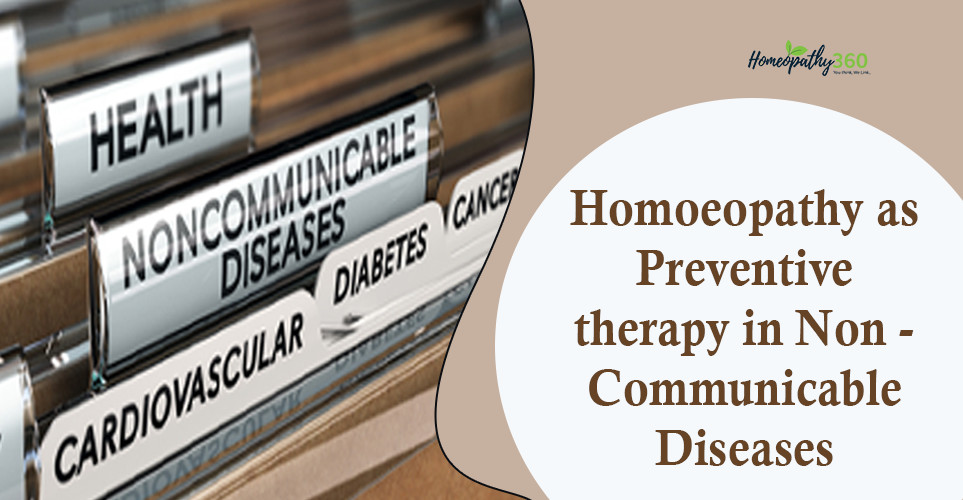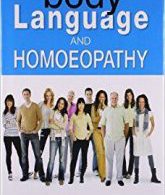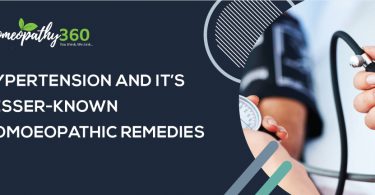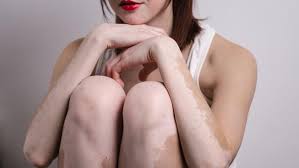
ABSTRACT
Noncommunicable diseases (NCDs), also known as chronic diseases, tend to be of long duration and are the result of a combination of genetic, physiological, environmental, and behavioural factors. The main types of NCD are cardiovascular diseases (such as heart attacks and stroke), cancers, chronic respiratory diseases (such as chronic obstructive pulmonary disease and asthma) and diabetes.
NCDs disproportionately affect people in low- and middle-income countries, where more than three quarters of global NCD deaths (31.4 million) occur.
Keywords: Non-communicable diseases, Homoeopathy, Organon of Medicine
Abbreviations: NCD (Non-Communicable Diseases)
INTRODUCTION:
- Noncommunicable diseases (NCDs) kill 41 million people each year, equivalent to 74% of all deaths globally.
- Each year, 17 million people die from a NCD before age 70; 86% of these premature deaths occur in low- and middle-income countries.
- Of all NCD deaths, 77% are in low- and middle-income countries.
- Cardiovascular diseases account for most NCD deaths, or 17.9 million people annually, followed by cancers (9.3 million), chronic respiratory diseases (4.1 million), and diabetes (2.0 million including kidney disease deaths caused by diabetes).
- These four groups of diseases account for over 80% of all premature NCD deaths.
- Tobacco use, physical inactivity, the harmful use of alcohol, unhealthy diets and air pollution all increase the risk of dying from an NCD.
- Detection, screening, and treatment of NCDs, as well as palliative care, are key components of the response to NCDs.
RISK FACTORS:
Modifiable behavioural risk factors
- Modifiable behaviours, such as tobacco use, physical inactivity, unhealthy diet and the harmful use of alcohol, all increase the risk of NCDs.
- Tobacco accounts for over 8 million deaths every year (including from the effects of exposure to second-hand smoke)
- 1.8 million annual deaths have been attributed to excess salt/sodium intake.
- More than half of the 3 million annual deaths attributable to alcohol use are from NCDs, including cancer.
- 830000 deaths annually can be attributed to insufficient physical activity.
Metabolic risk factors
Metabolic risk factors contribute to four key metabolic changes that increase the risk of NCDs:
- Raised blood pressure.
- Overweight/obesity.
- Hyperglycemia (high blood glucose levels); and
- Hyperlipidemia (high levels of fat in the blood).
In terms of attributable deaths, the leading metabolic risk factor globally is elevated blood pressure (to which 19% of global deaths are attributed) , followed by raised blood glucose and overweight and obesity.
Environmental risk factors
Several environmental risk factors contribute to NCDs. Air pollution is the largest of these, accounting for 6.7 million deaths globally, of which about 5.7 million are due to NCDs, including stroke, ischaemic heart disease, chronic obstructive pulmonary disease, and lung cancer.
SOCIOECONOMIC IMPACT:
NCDs threaten progress towards the 2030 Agenda for Sustainable Development, which includes a target of reducing the probability of death from any of the four main NCDs between ages 30 and 70 years by one third by 2030.
Poverty is closely linked with NCDs. The rapid rise in NCDs is predicted to impede poverty reduction initiatives in low-income countries, particularly by increasing household costs associated with health care. Vulnerable and socially disadvantaged people get sicker and die sooner than people of higher social positions, especially because they are at greater risk of being exposed to harmful products, such as tobacco, or unhealthy dietary practices, and have limited access to health services.
In low-resource settings, health-care costs for NCDs quickly drain household resources. The exorbitant costs of NCDs, including treatment, which is often lengthy and expensive, combined with loss of income, force millions of people into poverty annually and stifle development. (1)
Four Major Non-Communicable Diseases are:
- Cardiovascular diseases (including heart diseases and stroke)
- Diabetes
- Chronic respiratory diseases (including chronic obstructive pulmonary diseases)
- Cancer
PREVENTION
- Protecting people from tobacco smoke and banning smoking in public places, warning about the dangers of tobacco use, enforcing bans on tobacco advertising, promotion, and sponsorships, and raising taxes on tobacco.
- Restricting access to retailed alcohol, enforcing bans on alcohol advertising and raising taxes on alcohol.
- Reduce salt intake and salt content of food.
- Replacing trans-fat in food with polyunsaturated fat; and
- Promoting public awareness about diet and physical activity, including through mass media.
Research Studies conducted in homoeopathy:
- 5 cases of diagnosed HTG, with triglyceride levels above 200 were treated with homoeopathic medicine – Fucus vesiculosus, in mother tincture form. The primary outcome measure was to evaluate the reduction in the blood triglyceride levels. All the 5 cases showed a reduction in triglyceride levels to normal range within 4 months of starting the treatment. It was also observed that the borderline cholesterol levels and high LDL levels in 2 cases were found to reduce to normal. (2)
- 90 patients were studied by Randomized Single Blind Clinical Trial by dividing them into three groups – Constitutional, Organ and Placebo. In the later part of the study the Cross over design was adopted between the Constitutional group and the Placebo group. Results showed that at the end of the first 6 months of the trial, 67% patients improved from the constitutional group while the comparable figures from the Organ group and the Placebo group was 37% and 7% respectively. At the end of the trial 70% from the constitutional group improved as compared to 10% from the Organ remedy group and 7% from the placebo group (3)
- A prospective, double-blind, randomized, placebo-controlled, parallel-arm clinical trial was conducted at the Outpatient Clinic of the Mahesh Bhattacharyya Homoeopathy Medical College and Hospital, West Bengal. Out of 233 hypertensives assessed for eligibility, 150 were enrolled and randomized (verum/homoeopathy 70, control/placebo 80). A total of 18 dropped out and 132 were regular (verum 64, control 68). The outcome measures were assessed after 3 months and 6 months. Group differences were tested using the χ2 test and independent t test. Repeated measure (ANOVA) was performed to compare the data of two groups obtained longitudinally at baseline, three months, and six months. The baseline data were not significantly different between the groups. After six months, mean Systolic Blood Pressure (SBP) reduction was 26.6 mm Hg (95% CI 21.5, 31.7) in the homoeopathy group and SBP increased by 3.6 mm Hg (95% CI -8.7, 1.5) in the placebo group. Similarly, the mean Diastolic Blood Pressure (SBP) in the homoeopathy group reduced by 11.8 mm Hg (95% CI 9.2, 14.4) and increased by 1.6 mm Hg (95% CI -3.6, 0.4) in the placebo group. Repeated measures ANOVA also showed significant difference (P=0.0001) between the groups. Natrum muriaticum, Calcarea carb, Sulphur, Thuja occidentalis, Nitric acid and Medorrhinum were frequently prescribed. Individualized homoeopathy produced a significantly different hypotensive effect than placebo. (4)
- A single-blind, randomised, placebo-controlled trial was conducted to evaluate the change in systolic blood pressure (SBP) and diastolic blood pressure (DBP) every month for 3 months. Of 2127 patients screened, 217 patients who fitted the inclusion criteria were randomised to receive either homoeopathic Q potencies (or LM potencies) plus lifestyle modification (LSM) =116 or placebo + LSM = 101. LSM included physical activity and diet as part of the treatment regimen. Repeated‑measure ANOVA between the groups showed statistically significant difference (Wilk lambda 0.85, F = 12.12, df = 213, P = 0.0001), in both SBP and DBP favouring Individualised Homoeopathy (IH) along with LSM. Post hoc independent t‑test showed a significant mean reduction in SBP (mean difference 7.12 mm Hg, 95% confidence interval [CI] 4.72–9.53, P = 0.0001) and DBP (mean difference 5.76 mm Hg, 95% CI: 4.18–7.23, P = 0.0001) favouring Homoeopathy plus LSM group. Sulphur (n = 24), Natrum muriaticum (n = 21), Lycopodium (n = 16), Nux vomica (n = 12) and Phosphorus (n = 10) were the most useful medicines. IH in LM potency along with LSM was found effective over placebo along with LSM in the patients suffering from Stage I HTN. (5)
- A prospective, randomized, placebo‐controlled, double‐blind, three‐arm, multicentre, phase III study, evaluated the possible effects of additive homeopathic treatment compared with placebo in patients with stage IV NSCLC, with respect to QoL in the two randomized groups and survival time in all three groups. Treated patients visited the outpatients’ centres every 9 weeks: 150 patients with stage IV NSCLC were included in the study; 98 received either individualized homeopathic remedies (n = 51) or placebo (n = 47) in a double‐blinded fashion; and 52 control patients without any homeopathic treatment were observed for survival only. QoL as well as functional and symptom scales showed significant improvement in the homeopathy group when compared with placebo after 9 and 18 weeks of homeopathic treatment (p < .001). Median survival time was significantly longer in the homeopathy group (435 days) versus placebo (257 days; p = .010) as well as versus control (228 days; p < .001). Survival rate in the homeopathy group differed significantly from placebo (p = .020) and from control (p < .001). QoL improved significantly in the homeopathy group compared with placebo.(6)
- A 3-months, open-label, randomized, placebo-controlled trial (n = 60) was conducted at the OPD NIH, West Bengal. Patients were randomized to receive IHMs plus SP (n = 30) or identical-looking placebos plus SP (n = 30). Primary outcome measure was Medical Research Council (MRC) muscle strength grading scale; secondary outcomes were Stroke Impact Scale (SIS) version 2.0, Modified Ashworth Scale (MAS), and stroke recovery 0–100 visual analogue scale (VAS) scores; all measured at baseline and 3 months after intervention. Group differences and effect sizes (Cohen’s d) were calculated on intention-to-treat sample. Overall improvements were higher in the IHMs group than placebos with small to medium effect sizes, the group differences were statistically non-significant (all P>0.05, unpaired t-tests). Improvement in SIS physical problems was significantly higher in IHMs than placebos (mean difference 2.0, 95% confidence interval 0.3 to 3.8, P = 0.025, unpaired t-test). Causticum, Lachesis, and Nux vomica were the most frequently prescribed medicines. There was a small, but non-significant direction of effect favouring homeopathy against placebos in treatment of post-stroke hemiparesis.(7)
- In Homoeopathy, Hydrocotyle asiatica is used for the treatment of jaundice, skin diseases, dropsy, elephantiasis, leprosy, gonorrhea, leucorrhea, and nervous debility. HPTLC study indicated the presence of triterpene glycoside compound Asiatic acid in chloroform extract of Hydrocotyle asiatica. The mother tinctures prepared by authenticated plant samples showed maximum active constituents and prominent antioxidant activity as compared to the mother tinctures procured from the market. The present study justifies the homoeopathic usage of Hydrocotyle asiatica and highlights its healing properties. (8)
- The study was conducted using a hyperlipidaemic blood sample which was divided into eight parts. Six different potencies of Colch. at. were tested, and two controls, one negative and another positive were used. Cholesterol was estimated using Liberman Burchard reagent and spectrophotometry. In a hyperlipidemic blood sample, the range of reduction of cholesterol concentration was from 18.20% to 19.16%. The 6C potency removed 18.24% of cholesterol,12C potency removed 18.50% cholesterol,30C potency removed 19.02% cholesterol,200C potency removed 19.68% cholesterol and 10M potency removed 19.16% cholesterol. The maximum effect was seen in 1M potency where the reduction was 19.68 %. This study suggests that the Colchicum autumnale might be useful for the management of hypercholesterolemia. (9)
- The individualised homoeopathic medicine Nat. Sul. was found to be beneficial in this chronic case with improvement in impact on daily living assessed by the ORIDL scale. Tereb. o. was also beneficial as an intercurrent remedy in proteinuria. This case suggests that individualised homoeopathic medicines can be useful in those chronic cases where a long-term or lifelong dependency on conventional treatment is usually required (10)
- A patient suffering from PCOS, with Endometrial Hyperplasia and multiple UFs, was successfully treated with the homoeopathic medicine Pulsatilla nigricans. Repeat ultrasonography showed normal endometrial thickness, no hyperechoic or hypoechoic lesions in uterus and no ovarian PCOS morphology after treatment. Thus, the usefulness of homeopathic medicines for the treatment of multi-morbid pathologies related to reproductive system of women is demonstrated. (11)
- A case series of 7 PCOS patients treated with indicated constitutional homoeopathic medicines at NHMC, New Delhi. Overall improvement was assessed by improvement in signs and symptoms like restoration of regular menstrual cycles, weight loss, and disappearance of ovarian cysts, as evident in ultrasonography reports, and improved scores of the integrative Medicine Outcome Scale (IMOS) and quality of life (WHOQOL-BREF). The resolution of cysts in the ovaries, along with marked symptomatic improvement and improvement in quality of life in all seven patients, shows that homoeopathy has a potential for treating PCOS. Gradation of IMOS scale reduced to 1 in all seven patients after treatment showing complete recovery. One patient, who had presented with infertility, conceived during the treatment. Homoeopathic medicines such as Natrum muriaticum, Lycopodium, Silicea, Pulsatilla and Sepia were found most useful. (12)
In view with the Organon of medicine – (13)
Aphorism 4, Dr Hahnemann stated that “He is likewise a preserver of health if he knows the things that derange health and cause disease, and how to remove them from persons in health.”
Aphorism 5 stated that “Useful to the physician in assisting him to cure are the particulars of the most probable exciting cause of the acute disease, as also the most significant points in the whole history of the chronic disease, to enable him to discover its fundamental cause, which is due to a chronic miasm. In these investigations, the ascertainable physical constitution of the patient (especially when the disease is chronic), his moral and intellectual character, his occupation, mode of living and habits, his social and domestic relations, his age, sexual function, etc., are to be taken into consideration.”
Aphorism 81 fn ,Dr Hahnemann stated that transformation of psora into chronic diseases depends upon on the climate and the peculiar physical character of the place of abode, sometimes on the very great varieties in the physical and mental training of youth, both of which may have been neglected, delayed or carried to excess, or on their abuse in the business or conditions of life, in the matter of diet and regimen, passions, manners, habits and customs of various kinds.
Aphorism 208 stated that “the age of the patient, his mode of living and diet, his occupation, his domestic position, his social relations and so forth must next be taken into consideration, in order to ascertain whether these things have tended to increase his malady, or in how far they may favour or hinder the treatment. in like manner the state of his disposition and mind must be attended to, to learn whether that present any obstacle to the treatment, or requires to be directed, encouraged, or modified.
Case management (245-263) in the Aphorism 261 stated that” the most appropriate regimen during the employment of medicine in chronic diseases consists in the removal of such obstacles to recovery, and in supplying where necessary the reverse: innocent moral and intellectual recreation, active exercise in the open air in almost all kinds of weather (daily walks, slight manual labor), suitable, nutritious, unmedicinal food and drink, etc”.
THERAPEUTIC APPROACH :(14)
- ASPIDOSPERMA: Digitalis of the lungs, stimulates the respiratory centres, increasing the oxidation of blood and excretion of carbonic acid. Pulmonary stenosis. Cardiac asthma. Want of breath during exertion.
- CRATAEGUS: Arteriosclerosis. Said to have a solvent power on the crustaceous and calcareous deposits in the arteries. Diabetes, especially in children. Cardiac dropsy. Extreme dyspnea on least exertion, without a marked increase in pulse. Pulse accelerated, irregular, feeble, intermittent. Valvular murmurs, angina pectoris.
- DIGITALIS: Pulse is weak, irregular, intermittent, abnormally slow and dropsy of external and internal parts. The least movement causes violent palpitation, sensation as if it would cease beating, if he moves. Irregular heart especially due to mitral diseases.
- CHOLESTERINUM: an effective remedy for high level of cholesterol in blood. It also stops the degeneration of arterial walls. It also treats enlarged liver. Jaundice, gall stones.
- FEL TAURI: It is effective remedy in the treatment of high blood cholesterol. Obstruction of gall ducts. Jaundice. Biliary calculi.
- 6. URANIUM NITRICUM: Great emaciation, debility, and tendency to ascites with general dropsy. Causes glycosuria, polyuria. Produces nephritis, diabetes, hypertension, dropsy.
- SYZYGIUM JAMBOLANUM: Useful in Diabetes mellitus.
- TERMINALIA ARJUNA: Angina Pectoris, Hypertension, Ecchymosis. Irregular pulse, sometimes very quick and sometimes very feeble. Feeling as if heart would stop beating at any moment, palpitation violent, patient faints.
- RAUWOLFIA SERPENTINA: High blood pressure without marked atheromatous changes in the vessels.
- LYCOPUS: Lowers the blood pressure, reduces the heart rate, and increases the length of systole to a great degree. Passive haemorrhages.
- VANADIUM: Degenerative condition of liver and arteries. Tonic for digestive function and in early tuberculosis. Acts as an oxygen carrier and a catalyser, useful in wasting disease. Arteriosclerosis.
- ALLIUM SATIVUM: Has a Vaso-dilatory properties. Arterial hypotension begins usually in 30-45 minutes.
- ADONIS VERNALIS: fatty degeneration of heart, rheumatic endocarditis, myocarditis and cardiac dropsy with low vitality and weak, rapid and irregular pulse. It acts by regulating the pulse and increasing the contractile power of the heart and urinary secretions.
SUMMARY
- Homoeopathy has the great potential in treatment of Non communicable diseases, and it can be safely administered along with other essential medicines.
- Prevention and control of many of the non-communicable disease can be done with great efficacy and safety.
- While planning the organization of health services, the goal should be to shift the centre of gravity of chronic care delivery progressively towards the base of the health care pyramid by including the Homoeopathic system of Medicine.
- By strengthening the capacity for care by self, family, community, paramedic, and by encouraging guidelines-based practice and a rational referral-follow-up pattern which obviates the need for frequent revisits to secondary and tertiary care providers. Referral system for the Homoeopathy for NCD should be prioritized.
CONCLUSION
Homoeopathy being holistic in its approach, is based on the natural law of healing i.e., Similia similibus curantur which means “likes are cured by likes” which is of utmost importance and each person is treated considering his own individuality. The treatment of ncd starts with a meticulous case taking process. A proper analysis of risk factors, accessory circumstances, temperament, constitution and underlying miasm is essential for forming the totality of symptoms. A constitutional homoeopathic medicine is prescribed based on totality of symptoms.
People who take constitutional homoeopathic medicines delay ncd diseases like hypertension, diabetes, dyslipidemia etc. This is especially significant in cases with family history of ncd and even diagnosed cases of ncd can be well managed with homoeopathic remedies provided medicine is prescribed based on constitutional totality and not specific medicine for the disease symptoms. The benefit of homeopathy is that when a person takes the right remedy not only does the disease being targeted is cured, but the overall immunity of the person is also boosted and their tendency to any other disease they are susceptible to, also reduces. Homeopathy also gives good positive results when administered as an adjunct to conventional medicine or any other line of therapy in complicated or late stages of these diseases where conventional medicine doesn’t have the complete key.
REFERENCES:
- https://www.who.int/news-room/fact-sheets/detail/noncommunicable-diseases
- Ponnam HB, Akondi BR, Mohammed I, Chakali B. Hypertriglyceridemia treated with Fucus vesiculosus a case series. J Ayurveda Integr Med 2021;12;549-52
- Tiwari NL, Tamboli P. Diabetes mellitus-defining scope and clinical approach for homoeopathic management. Indian J Res Homoeopathy 2008; 2:28-36.
- Saha S, Koley M, Hossain SI, Mundle M, Ghosh S, Nag G, et al. Individualized homeopathy versus placebo in essential hypertension: A double-blind randomized controlled trial. Indian J Res Homeopathy 2013; 7:62-71.
- Varanasi R, Kolli R, Rai Y, Ramesh D, Kiranmayee RG, Reddy GR, et al. Effects of individualised homeopathic intervention in Stage I essential hypertension: A single-blind, randomised, placebo-controlled trial. Indian J Res Homeopathy 2020; 14:3-14
- Frass M, Lechleitner P, Gründling C, Pirker C, Grasmuk-Siegl E, Domayer J, et al. Homeopathic treatment as an add-on therapy may improve quality of life and prolong survival in patients with non-small cell lung cancer: A prospective, randomized, placebo-controlled, doubleblind, three-arm, multicenter study. Oncologist 2020;25: e1930-55.
- Dutta A, Singh S, Saha S, Rath P, Sehrawat N, Singh NK. Efficacy of Individualized Homeopathic Medicines in Treatment of Post-Stroke Hemiparesis: A Randomized Trial. Explore; 2022.
- Mishra R, Dwivedi BK, Gupta D. Comparative study of high performance thin-layer chromatography and antioxidant potential of Hydrocotyle asiatica mother tincture used in homoeopathy. Indian J Res Homoeopathy 2022; 16:200-210
- Nithya T, Ali KR, Veluthoor S, Jijith US, Perveen PS, Alloor A, et al. Cholesterol lowering activity of homoeopathic preparations of Colchicum autumnale-An in vitro study. Indian J Res Homoeopathy 2022; 16:211-215.
- Kumari P, Verma R. Nephrotic syndrome treated with homoeopathy: An evidence-based case-report. Indian J Res Homoeopathy 2022; 16:224-230.
- Shinde V. Polycystic ovarian syndrome with endometrial hyperplasia and uterine fibroids treated with homoeopathy: A case report. Indian J Res Homoeopathy 2022; 20:231-238.
- Raizada S. Homoeopathic management of polycystic ovarian syndrome-A case series. Indian J Res Homoeopathy 2022; 16:239-254
- Hahnemann Samuel. Organon of medicine. 5th & 6th edition. New Delhi: B. Jain Publishers (P) Ltd.; 2015
- Boericke William; Pocket manual of Homoeopathic Material Medica and Repertory; New Delhi: B Jain Publishers (P) ltd; 9th Edition





